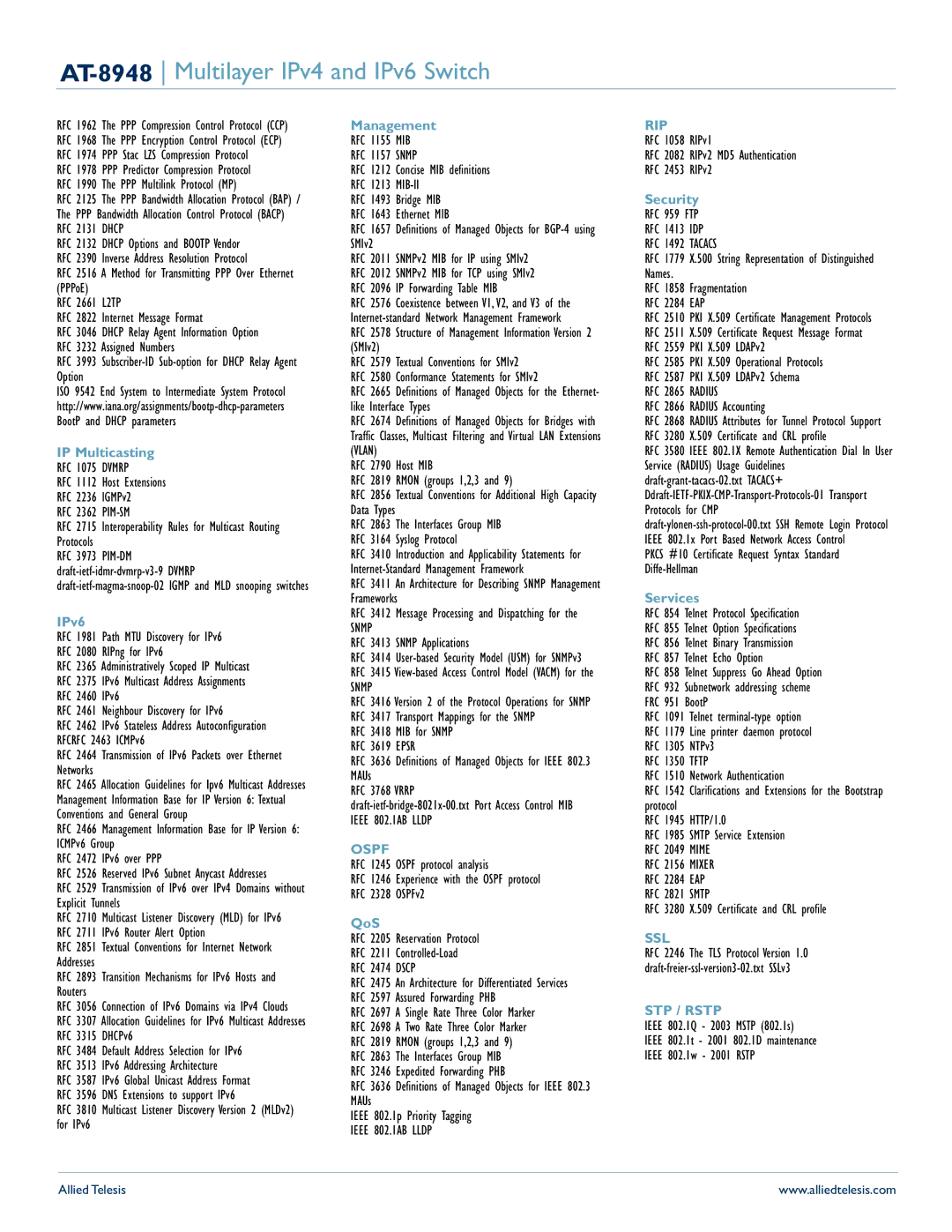RFC 1962 The PPP Compression Control Protocol (CCP) RFC 1968 The PPP Encryption Control Protocol (ECP) RFC 1974 PPP Stac LZS Compression Protocol
RFC 1978 PPP Predictor Compression Protocol RFC 1990 The PPP Multilink Protocol (MP)
RFC 2125 The PPP Bandwidth Allocation Protocol (BAP) / The PPP Bandwidth Allocation Control Protocol (BACP) RFC 2131 DHCP
RFC 2132 DHCP Options and BOOTP Vendor RFC 2390 Inverse Address Resolution Protocol
RFC 2516 A Method for Transmitting PPP Over Ethernet (PPPoE)
RFC 2661 L2TP
RFC 2822 Internet Message Format
RFC 3046 DHCP Relay Agent Information Option RFC 3232 Assigned Numbers
RFC 3993 Subscriber-ID Sub-option for DHCP Relay Agent Option
ISO 9542 End System to Intermediate System Protocol http://www.iana.org/assignments/bootp-dhcp-parameters BootP and DHCP parameters
IP Multicasting
RFC 1075 DVMRP
RFC 1112 Host Extensions RFC 2236 IGMPv2
RFC 2362 PIM-SM
RFC 2715 Interoperability Rules for Multicast Routing Protocols
RFC 3973 PIM-DM draft-ietf-idmr-dvmrp-v3-9 DVMRP
draft-ietf-magma-snoop-02 IGMP and MLD snooping switches
IPv6
RFC 1981 Path MTU Discovery for IPv6 RFC 2080 RIPng for IPv6
RFC 2365 Administratively Scoped IP Multicast RFC 2375 IPv6 Multicast Address Assignments RFC 2460 IPv6
RFC 2461 Neighbour Discovery for IPv6
RFC 2462 IPv6 Stateless Address Autoconfiguration RFCRFC 2463 ICMPv6
RFC 2464 Transmission of IPv6 Packets over Ethernet Networks
RFC 2465 Allocation Guidelines for Ipv6 Multicast Addresses Management Information Base for IP Version 6: Textual Conventions and General Group
RFC 2466 Management Information Base for IP Version 6: ICMPv6 Group
RFC 2472 IPv6 over PPP
RFC 2526 Reserved IPv6 Subnet Anycast Addresses
RFC 2529 Transmission of IPv6 over IPv4 Domains without Explicit Tunnels
RFC 2710 Multicast Listener Discovery (MLD) for IPv6 RFC 2711 IPv6 Router Alert Option
RFC 2851 Textual Conventions for Internet Network Addresses
RFC 2893 Transition Mechanisms for IPv6 Hosts and Routers
RFC 3056 Connection of IPv6 Domains via IPv4 Clouds RFC 3307 Allocation Guidelines for IPv6 Multicast Addresses RFC 3315 DHCPv6
RFC 3484 Default Address Selection for IPv6 RFC 3513 IPv6 Addressing Architecture
RFC 3587 IPv6 Global Unicast Address Format RFC 3596 DNS Extensions to support IPv6
RFC 3810 Multicast Listener Discovery Version 2 (MLDv2) for IPv6
Management
RFC 1155 MIB
RFC 1157 SNMP
RFC 1212 Concise MIB definitions RFC 1213 MIB-II
RFC 1493 Bridge MIB
RFC 1643 Ethernet MIB
RFC 1657 Definitions of Managed Objects for BGP-4 using SMIv2
RFC 2011 SNMPv2 MIB for IP using SMIv2 RFC 2012 SNMPv2 MIB for TCP using SMIv2 RFC 2096 IP Forwarding Table MIB
RFC 2576 Coexistence between V1, V2, and V3 of the Internet-standard Network Management Framework
RFC 2578 Structure of Management Information Version 2 (SMIv2)
RFC 2579 Textual Conventions for SMIv2
RFC 2580 Conformance Statements for SMIv2
RFC 2665 Definitions of Managed Objects for the Ethernet- like Interface Types
RFC 2674 Definitions of Managed Objects for Bridges with Traffic Classes, Multicast Filtering and Virtual LAN Extensions (VLAN)
RFC 2790 Host MIB
RFC 2819 RMON (groups 1,2,3 and 9)
RFC 2856 Textual Conventions for Additional High Capacity Data Types
RFC 2863 The Interfaces Group MIB RFC 3164 Syslog Protocol
RFC 3410 Introduction and Applicability Statements for Internet-Standard Management Framework
RFC 3411 An Architecture for Describing SNMP Management Frameworks
RFC 3412 Message Processing and Dispatching for the
SNMP
RFC 3413 SNMP Applications
RFC 3414 User-based Security Model (USM) for SNMPv3 RFC 3415 View-based Access Control Model (VACM) for the
SNMP
RFC 3416 Version 2 of the Protocol Operations for SNMP RFC 3417 Transport Mappings for the SNMP
RFC 3418 MIB for SNMP RFC 3619 EPSR
RFC 3636 Definitions of Managed Objects for IEEE 802.3 MAUs
RFC 3768 VRRP
draft-ietf-bridge-8021x-00.txt Port Access Control MIB IEEE 802.1AB LLDP
OSPF
RFC 1245 OSPF protocol analysis
RFC 1246 Experience with the OSPF protocol RFC 2328 OSPFv2
QoS
RFC 2205 Reservation Protocol RFC 2211 Controlled-Load RFC 2474 DSCP
RFC 2475 An Architecture for Differentiated Services RFC 2597 Assured Forwarding PHB
RFC 2697 A Single Rate Three Color Marker
RFC 2698 A Two Rate Three Color Marker RFC 2819 RMON (groups 1,2,3 and 9) RFC 2863 The Interfaces Group MIB
RFC 3246 Expedited Forwarding PHB
RFC 3636 Definitions of Managed Objects for IEEE 802.3 MAUs
IEEE 802.1p Priority Tagging IEEE 802.1AB LLDP
RIP
RFC 1058 RIPv1
RFC 2082 RIPv2 MD5 Authentication
RFC 2453 RIPv2
Security
RFC 959 FTP
RFC 1413 IDP RFC 1492 TACACS
RFC 1779 X.500 String Representation of Distinguished Names.
RFC 1858 Fragmentation RFC 2284 EAP
RFC 2510 PKI X.509 Certificate Management Protocols RFC 2511 X.509 Certificate Request Message Format RFC 2559 PKI X.509 LDAPv2
RFC 2585 PKI X.509 Operational Protocols RFC 2587 PKI X.509 LDAPv2 Schema RFC 2865 RADIUS
RFC 2866 RADIUS Accounting
RFC 2868 RADIUS Attributes for Tunnel Protocol Support RFC 3280 X.509 Certificate and CRL profile
RFC 3580 IEEE 802.1X Remote Authentication Dial In User Service (RADIUS) Usage Guidelines draft-grant-tacacs-02.txt TACACS+ Ddraft-IETF-PKIX-CMP-Transport-Protocols-01 Transport Protocols for CMP
draft-ylonen-ssh-protocol-00.txt SSH Remote Login Protocol IEEE 802.1x Port Based Network Access Control
PKCS #10 Certificate Request Syntax Standard Diffe-Hellman
Services
RFC 854 Telnet Protocol Specification
RFC 855 Telnet Option Specifications
RFC 856 Telnet Binary Transmission RFC 857 Telnet Echo Option
RFC 858 Telnet Suppress Go Ahead Option RFC 932 Subnetwork addressing scheme FRC 951 BootP
RFC 1091 Telnet terminal-type option RFC 1179 Line printer daemon protocol RFC 1305 NTPv3
RFC 1350 TFTP
RFC 1510 Network Authentication
RFC 1542 Clarifications and Extensions for the Bootstrap protocol
RFC 1945 HTTP/1.0
RFC 1985 SMTP Service Extension RFC 2049 MIME
RFC 2156 MIXER
RFC 2284 EAP
RFC 2821 SMTP
RFC 3280 X.509 Certificate and CRL profile
SSL
RFC 2246 The TLS Protocol Version 1.0 draft-freier-ssl-version3-02.txt SSLv3
STP / RSTP
IEEE 802.1Q - 2003 MSTP (802.1s)
IEEE 802.1t - 2001 802.1D maintenance
IEEE 802.1w - 2001 RSTP

